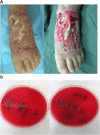Preoperative irrigation and vacuum sealing drainage with antibiotic-containing drainage fluid of foot and ankle wounds improves outcome of reconstructive skin flap surgery
- PMID: 31747959
- PMCID: PMC6869274
- DOI: 10.1186/s13018-019-1418-0
Preoperative irrigation and vacuum sealing drainage with antibiotic-containing drainage fluid of foot and ankle wounds improves outcome of reconstructive skin flap surgery
Abstract
Objectives: By observing the infection and soft tissue defect on the wound surface of the foot and ankle, this paper attempts to explore the effect of preoperative irrigation and vacuum sealing drainage with antibiotic-containing drainage fluid (abPI-VSD) on the bacterial quantity and the local inflammatory response at the flap, and further to provide a basis for applying this technique before a reconstructive skin flap surgery of foot and ankle wounds.
Methods: Seventy-five patients were randomly divided into two groups, and all surgeries were done by one physician. The flap reconstructions were done to 31 cases with the abPI-VSD being used (group A); the flap reconstructions were done to the rest 44 cases after wound cleaning using antibiotic irrigation solution without the use of the abPI-VSD (group B). Quantitative bacteriology was made to group A before and after the use of abPI-VSD; quantitative bacteriology was made to group B before and after wound cleaning. Then, the reconstructive skin flap surgery was done. After the surgeries, the time of local inflammatory response at the flap in both groups were recorded. The measured bacterial quantity was evaluated in logarithm and by t test.
Results: The bacterial quantity was 3.2 ± 1.9 × 107 cfu/g in group A before the use of abPI-VSD and 2.3 ± 2.0 × 107 in group B (P > 0.05) before debridement. The bacterial quantity was 1.2 ± 2.0 × 104 cfu/g in group A after abPI-VSD and was 2.9 ± 4.0 × 106 in group B after wound cleaning (P < 0.05). The time of postoperative inflammatory response in the flap was 8 ± 2.5 days in group A and 13 ± 3.4 days in group B (P < 0.05).
Conclusions: abPI-VSD can distinctly reduce the bacterial quantity on the surface of the wound, provide a good condition of tissue bed for the flap reconstruction, and effectively control the local inflammatory response at the flap and hence improve the survival quality of the flap.
Keywords: Bacterial infection; Flap reconstruction; Inflammatory response.
Conflict of interest statement
The authors declare that they have no competing interests.
Figures



References
Publication types
MeSH terms
Substances
LinkOut - more resources
Full Text Sources
Medical

